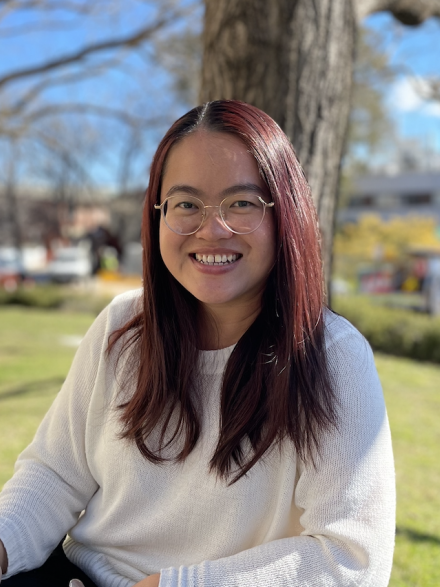Title: Postdoctoral Fellow
Country/Region: Australia
Period: 2024/5/20-2024/08/16
Theme: Understanding Subduction and Arc-continent Collision Processes with Passive Seismic Imaging
Host: Kiwamu NISHIDA
Introduction: Dr. Ping Zhang is currently a postdoc at the Australian National University (ANU). She recently earned her Ph.D. from ANU in 2023, following the completion of her M.S. and B.S. degrees from the University of Science and Technology of China (USTC) in 2017 and Jilin University in 2014, respectively. Her primary research interests lie in structural and observational seismology, specifically focusing on imaging the lithospheric structure and deciphering past and present tectonic processes occurring in active plate boundaries and “stable” cratons. She is particularly passionate about addressing longstanding tectonic challenges, notably the complexities arising from the arc-continent collision in Indonesia and Timor Leste as well as craton evolution in Australia and China, systems not fully explained by the classical modern plate tectonic theory. Her work integrates multiple seismological datasets (receiver function, autocorrelation, surface wave data, and body wave data), complemented by a range of independent observations from geology, geochemistry, and petrology. Her active research projects involve applying such novel and interdisciplinary approach to new observations obtained in previously unexplored or underexplored regions, including Eastern Indonesia, Timor-Leste, New Zealand, and Western Australia.
Homepage: https://earthsciences.anu.edu.au/people/dr-ping-zhang
Google Scholar: https://scholar.google.com/citations?user=M05A644AAAAJ&hl=en
Research Report:
During my 3-month visit to the ERI, I collaborated with Prof. Kiwamu Nishida on seismic interferometry, focusing on surface and body wave extractions. We initiated a project to image the crustal structure of Mt Fuji with ambient noise tomography, utilizing 3 years of continuous data (2002-2005) recorded by 173 seismic stations. This project aims for potential data-driven methodolody development and to enhance our understanding of Mt Fuji’s complex magmatic systems. Preliminary results were achieved, and we plan to prepare a manuscript after further tests and interpretations. In collaboration with Assoc. Prof. Hongjian Fang from Sun Yat-sen University in China, who was also hosted by Prof. Nishida, we also explored the body wave reflection signals using global P-wave microseism data from the Hi-net. Additionally, I delivered a talk at the ERI Volcano Research Centre on July 1, 2024, titled: Unveiling the Banda Arc-Australian Continent Collision: New Insights from Passive Seismic Imaging. I also met and discussed with other ERI researchers on subduction and collision tectonics in Indonesia, Japan, and New Zealand, as well as technical aspects on dealing with OBS and island data. Interactions with other visitors and seminar speakers at ERI also greatly contributed to my research and career development.
Beyond ERI, I attended the Japan Geoscience Union Meeting (JpGU) 2024 and participated in two field trips to learn subduction zone geology (Boso Peninsular) and volcanology of Mt Fuji and Hakone. I also visited the Earth-Life Science Institute (ELSI) based at the Tokyo Institute of Technology in Japan, invited and hosted by Prof. Christine Houser and Prof. John Hernlund. I benefited from a field trip organized by the ERI international office to study the structural geology of the Japan Median Tectonic Line and revisit Mt Fuji. What’s more, I met with professors at Tokyo College and the Atmosphere and Ocean Research Institute at UTokyo to discuss the Strategic Partnership projects between the UTokyo and the Australian National University (ANU). These meetings led to my discussion with the head of the ERI international office, Prof. Masataka Kinoshita, about developing new exchange projects in the future. Finally, I would like to acknowledge Yoko and the ERI international office team for their assistance with logistics and administrative matters.
Beyond ERI, I attended the Japan Geoscience Union Meeting (JpGU) 2024 and participated in two field trips to learn subduction zone geology (Boso Peninsular) and volcanology of Mt Fuji and Hakone. I also visited the Earth-Life Science Institute (ELSI) based at the Tokyo Institute of Technology in Japan, invited and hosted by Prof. Christine Houser and Prof. John Hernlund. I benefited from a field trip organized by the ERI international office to study the structural geology of the Japan Median Tectonic Line and revisit Mt Fuji. What’s more, I met with professors at Tokyo College and the Atmosphere and Ocean Research Institute at UTokyo to discuss the Strategic Partnership projects between the UTokyo and the Australian National University (ANU). These meetings led to my discussion with the head of the ERI international office, Prof. Masataka Kinoshita, about developing new exchange projects in the future. Finally, I would like to acknowledge Yoko and the ERI international office team for their assistance with logistics and administrative matters.
View All
Fiscal Year: 2024
Fiscal Year: 2024


